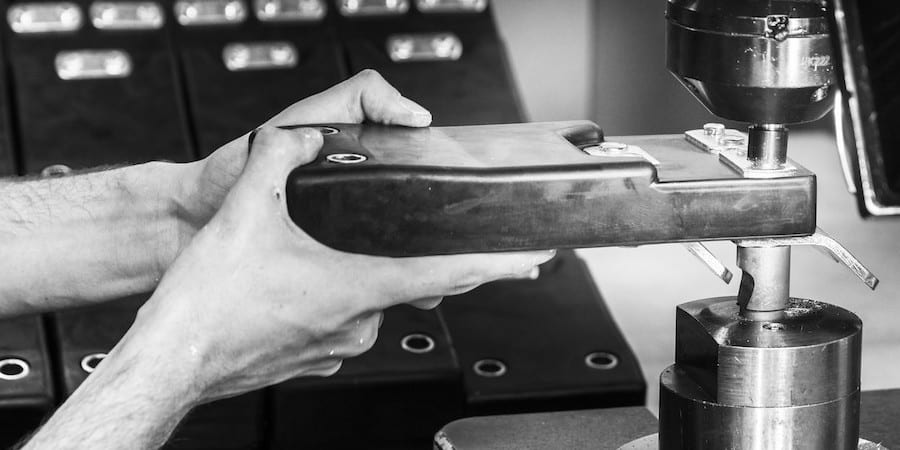
When the boss joins people on the production line
FEATURE – At Nijhuis Mitech, management is so involved that the owner can often be seen at the gemba running experiments with people. The transformation that ensued is helping the firm become more efficient and stay competitive.
Words: Carolien Nijhuis, Owner, Nijhuis Mitech
You don’t always need a burning platform to build improvement in your work, but you do need to be forward-looking. And have vision.
Nijhuis Mitech produces a wide range of components for the meat industry – including de-hairing hog paddles. Our company is healthy, but around a year ago we decided to embrace lean thinking as a way to build on our competitive advantage. Our products are high-quality and durable, and we have the ability to customize them to fit our clients’ needs and machines in a very short time. That’s how we are differentiating ourselves, which is particularly important if you think that companies in Asia are manufacturing similar components at 30% of the cost. Our competitor might offer cheaper products, but many of them have never even seen a slaughterhouse in their lives!
My great-grandfather started in the business of producing slaughterhouse machinery, so manufacturing these products (our yearly output is currently around 90,000 pieces) has become part of our DNA. I have worked on the line myself for many years, which has given me a deep understanding of the product and the process.
I believe that learning doesn’t happen only within the business, but also by interacting with customers and suppliers – understanding their needs and the way they work. We source our raw materials in Europe, for example, because we know how important it is for our quality to know where they come from. (We are also looking to buy a small steel company, to fully control our supply going forward.)
We have been using lean for around a year, but we were focusing on being smarter at producing and generating less waste way before then. We just didn’t call it “lean”. One year in, we are already seeing a very positive impact on our company culture: people are encouraged to take the initiative and actively participate in the improvement of the work, and are constantly coming up with new ideas. Experimentation is a necessary condition for change to come about, but for it to happen you need to accept – and let people see – that making mistakes is okay. In fact, it is necessary to learn (although we do need to do some homework beforehand, because the materials we buy to manufacture are quite expensive).
As part of our lean efforts, we have introduced checks of raw materials when they are first delivered to us. That way, a problem can be fixed as soon as it is detected. We also introduced a new quality system, with a quality professional reviewing the product at each step of the process. If the problem is small, it is fixed on the spot; if it’s bigger and warrants a change in the work, we stop, assess and decide the best course of action. Additionally, our Quality Manager walks around the gemba two-to-three times a day, to make sure everybody is receiving the help they need.
Another important change was the introduction of a weekly plan to schedule and visualize the work that is coming up: what we need to produce, what the client’s specifications are, what assembly work is required, and so on. This system links all the departments involved in production. Our orders chart allows every worker to check their work to see if they are on track or not. Color codes make this assessment even faster and clearer: a green card means the person is on track; the yellow card is a way for a struggling worker to ask for help with the workload; the red card means they are behind schedule. It’s real-time monitoring, and it works like a charm.
I can also share a couple of interesting figures. Since the introduction of lean, the time it takes us to make a product has shrunk by 20%. We have also gone from three days’ worth of safety stock (buffer) to one. And this is just the beginning!
LEADING FROM THE GEMBA
Over time, I have learned to speak to our people in a way they can understand, clearly and with consistency. Telling them that “we want to make the best product out there” only goes so far. They need to understand why lean is good for the company and, therefore, for them. It’s the usual “what’s in it for me?” question.
Our people have learned to think lean, but that doesn’t mean that every change is welcome. Sometimes, they might be scared to try something new or simply not be convinced that it can change the process for the better. What I normally do in those instances is get down to the line and try it myself. I have worked on the line, making the product myself, for nine years. The knowledge I have acquired during that time is extremely beneficial, because it allows me to be directly involved in the work every time I need to demonstrate that a change we are proposing can work, and what it would allow us to achieve.
This to me is what “leading by example” really means. It sends a strong message out to our folks that we are all in this together. I don’t want to be one of those managers sitting in their office, with their feet on the desk. I want to make change happen with my people. You can go on gemba walks, draft a lovely mission statement and write lots of A3s, but until you get to intimately know the work, you won’t be able to tap into the full potential of your company.
One of my favourite things about lean is seeing the transformation people go through as they discover its power. When we first started, for instance, our Quality Manager was very much against lean. She had worked for a multinational for many years and seen lean in action there (whether that was “real lean”, I am not too sure), but she had a terrible experience with it. Our approach – part of which is certainly leadership “getting their hands dirty” – won her over, and she’s now one of lean’s staunchest supporters.
I love seeing people own the processes and constantly make suggestions on how to improve them. They now realize they are making a difference at Nijhuis Mitech and are not simply coming to work to get paid. Isn’t it just wonderful when work becomes fun?
THE AUTHOR

Read more


BOOK EXCERPT – The city of Breda in the Netherlands has been on a lean journey for the past six years. Today we share an excerpt from the book The Lean Government, which sets the scene for the transformation.


OPINION – When do our mistake become an ominous sign that we are giving up on our customers and people? Following the salmonella contamination in cereals in Israel, the author reflects on business purpose and the importance of transparency.


FEATURE – Attracting, developing and retaining talent has become a pressing issue in the corporate world, as new generations show skepticism towards traditional management. Lean is the answer, say the authors.


FEATURE – As businesses struggle with disruption and an uncertain future in the midst of the Covid-19 crisis, the author suggests they turn to lean daily management and get into an experimentation mindset.

